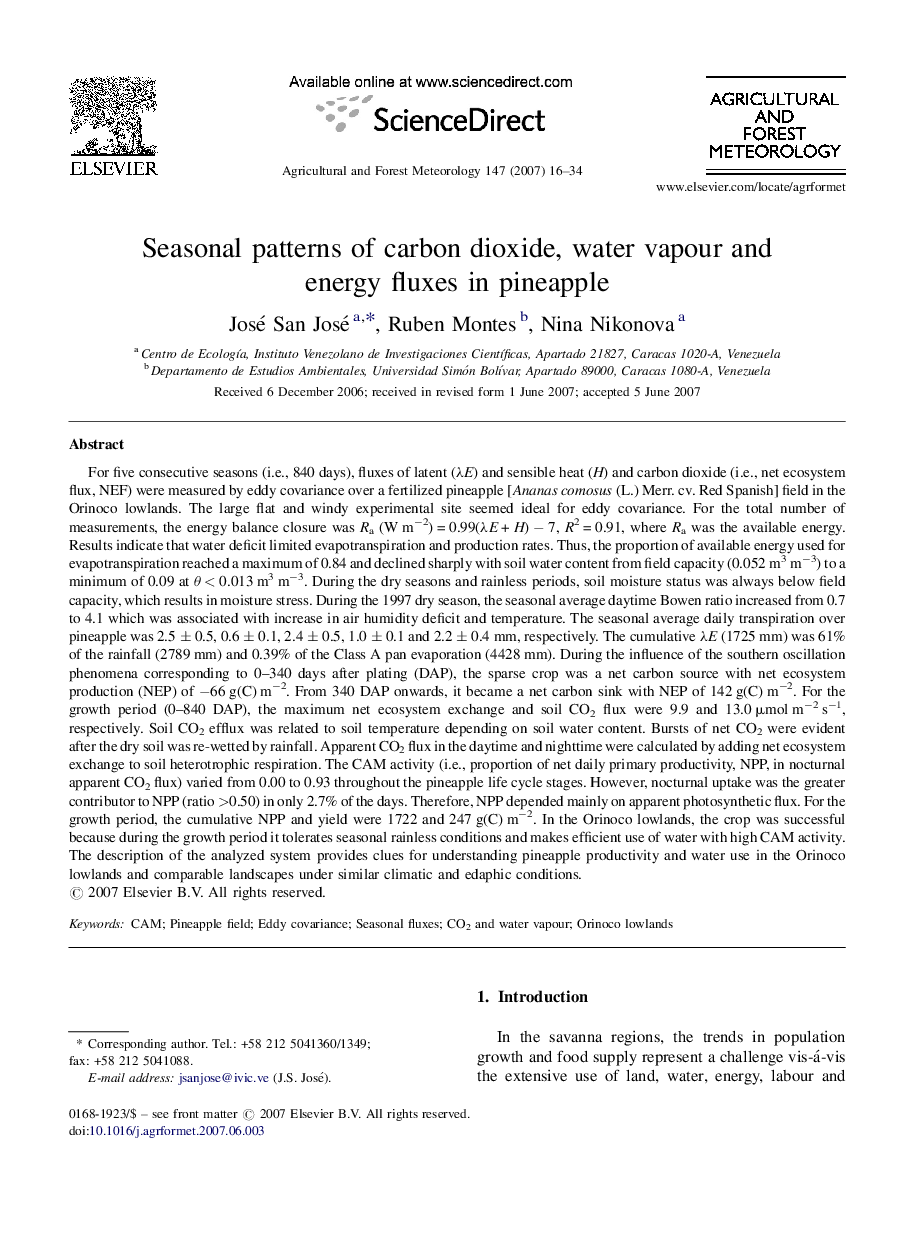| Article ID | Journal | Published Year | Pages | File Type |
|---|---|---|---|---|
| 82861 | Agricultural and Forest Meteorology | 2007 | 19 Pages |
For five consecutive seasons (i.e., 840 days), fluxes of latent (λE) and sensible heat (H) and carbon dioxide (i.e., net ecosystem flux, NEF) were measured by eddy covariance over a fertilized pineapple [Ananas comosus (L.) Merr. cv. Red Spanish] field in the Orinoco lowlands. The large flat and windy experimental site seemed ideal for eddy covariance. For the total number of measurements, the energy balance closure was Ra (W m−2) = 0.99(λE + H) − 7, R2 = 0.91, where Ra was the available energy. Results indicate that water deficit limited evapotranspiration and production rates. Thus, the proportion of available energy used for evapotranspiration reached a maximum of 0.84 and declined sharply with soil water content from field capacity (0.052 m3 m−3) to a minimum of 0.09 at θ < 0.013 m3 m−3. During the dry seasons and rainless periods, soil moisture status was always below field capacity, which results in moisture stress. During the 1997 dry season, the seasonal average daytime Bowen ratio increased from 0.7 to 4.1 which was associated with increase in air humidity deficit and temperature. The seasonal average daily transpiration over pineapple was 2.5 ± 0.5, 0.6 ± 0.1, 2.4 ± 0.5, 1.0 ± 0.1 and 2.2 ± 0.4 mm, respectively. The cumulative λE (1725 mm) was 61% of the rainfall (2789 mm) and 0.39% of the Class A pan evaporation (4428 mm). During the influence of the southern oscillation phenomena corresponding to 0–340 days after plating (DAP), the sparse crop was a net carbon source with net ecosystem production (NEP) of −66 g(C) m−2. From 340 DAP onwards, it became a net carbon sink with NEP of 142 g(C) m−2. For the growth period (0–840 DAP), the maximum net ecosystem exchange and soil CO2 flux were 9.9 and 13.0 μmol m−2 s−1, respectively. Soil CO2 efflux was related to soil temperature depending on soil water content. Bursts of net CO2 were evident after the dry soil was re-wetted by rainfall. Apparent CO2 flux in the daytime and nighttime were calculated by adding net ecosystem exchange to soil heterotrophic respiration. The CAM activity (i.e., proportion of net daily primary productivity, NPP, in nocturnal apparent CO2 flux) varied from 0.00 to 0.93 throughout the pineapple life cycle stages. However, nocturnal uptake was the greater contributor to NPP (ratio >0.50) in only 2.7% of the days. Therefore, NPP depended mainly on apparent photosynthetic flux. For the growth period, the cumulative NPP and yield were 1722 and 247 g(C) m−2. In the Orinoco lowlands, the crop was successful because during the growth period it tolerates seasonal rainless conditions and makes efficient use of water with high CAM activity. The description of the analyzed system provides clues for understanding pineapple productivity and water use in the Orinoco lowlands and comparable landscapes under similar climatic and edaphic conditions.
